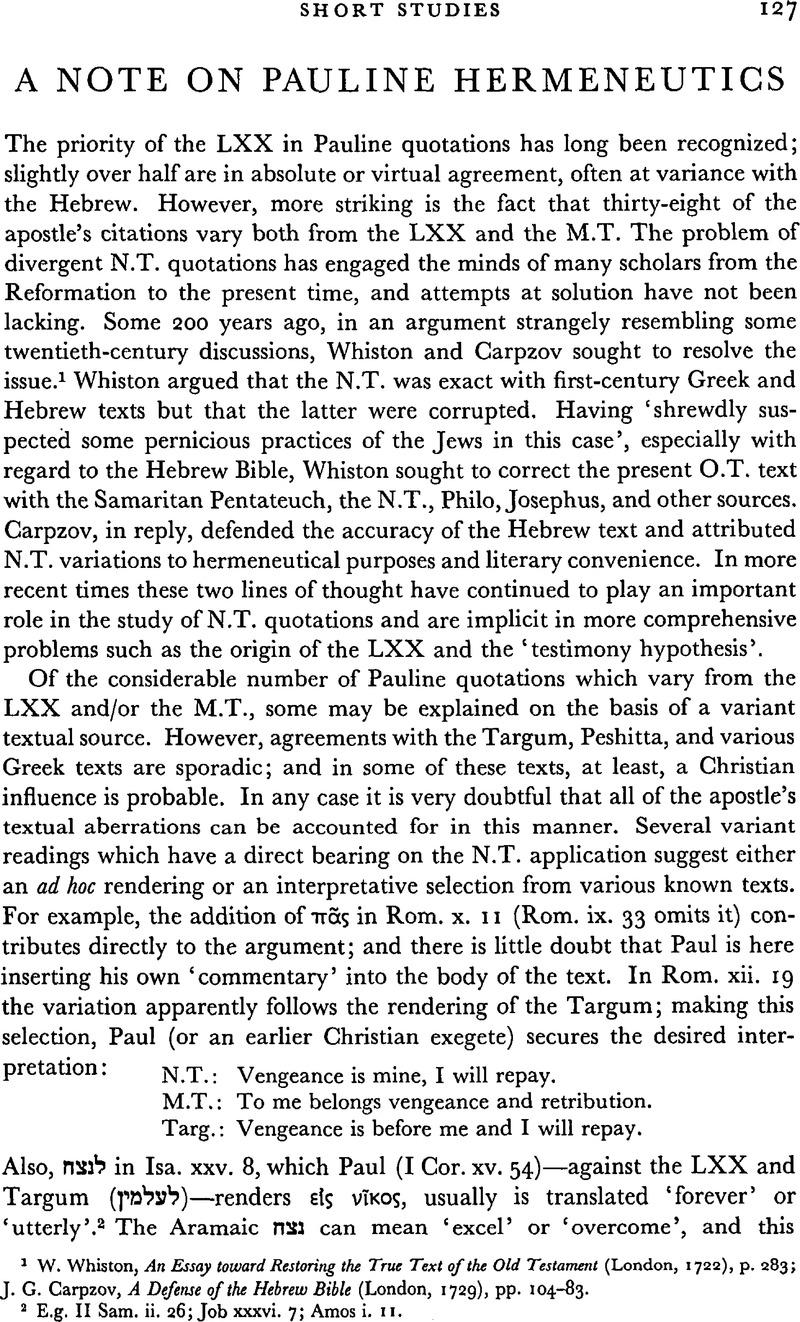Article contents
A Note on Pauline Hermeneutics
Published online by Cambridge University Press: 05 February 2009
Abstract

- Type
- Short Studies
- Information
- Copyright
- Copyright © Cambridge University Press 1955
References
1 Whiston, W.An Essay toward Restoring the True Text of the Old Testament (London, 1722), p. 283Google Scholar; Carpzov, J. G., A Defense of the Hebrew Bible (London, 1729), pp. 104–83.Google Scholar
2 E.g. II Sam. ii. 26; Job xxxvi. 7; Amos i. 11.
1 Stendahl, K., The School of St Matthew (Uppsala, 1954). Cf. New Testament Studies, 1 (November 1954), 155 ff.Google Scholar
2 ibid. pp. 195, 200f.
3 ibid. p. 35. Pesher (![]() ) occurs as a technical term in D.S.H. Whether it should be rendered ‘commentary’, ‘interpretation’, or ‘midrash’ is uncertain; Stendahl classifies it as a midrash parallel to halacha and haggada. Cf. the discussion in B. J. Roberts, ‘Some Observations on the Damascus Documents and the Dead Sea Scrolls’, Bulletin of the John Rylands Library, 34 (1951–1952), 367 ff.Google Scholar
) occurs as a technical term in D.S.H. Whether it should be rendered ‘commentary’, ‘interpretation’, or ‘midrash’ is uncertain; Stendahl classifies it as a midrash parallel to halacha and haggada. Cf. the discussion in B. J. Roberts, ‘Some Observations on the Damascus Documents and the Dead Sea Scrolls’, Bulletin of the John Rylands Library, 34 (1951–1952), 367 ff.Google Scholar
1 Roberts (ibid.) regards this factor as the chief link between D.S.S. and the N.T.
2 Stendahl, , p. 185.Google Scholar
3 ibid. p. 189.
4 Stendahl, , pp. 185–90.Google Scholar
5 ibid. p. 190.
1 Stendahl recognizes that this type of interpretation is present in apocalyptic writings and occasionally in the rabbis (ibid. p. 195), and that it is found in other N.T. writings, especially the Fourth Gospel. But he concludes that there were fewer intentional changes based on the Hebrew, and ‘thus the elaborate stage of the pesher found in Matthew scarcely existed’ (ibid. p. 202).
2 The manner in which this citation is parenthetically inserted suggests that the whole verse—the O.T. text plus the interpretation—was taken as a quotation by Paul. Cf. I Cor. xv. 45; I Tim. v. 18; II Tim. ii. 19.
3 On Rom. i. 17, cf. Burney, C. F., The Gospel in the Old Testament (Edinburgh, 1921), pp. 129f.Google Scholar; the LXX ‘to whom’ in Rom. xv. 21 accords much more explicitly with Paul's application than the indefinite ![]() of the M.T.
of the M.T.
4 E.g. Rom. iii. 18 (![]() to
to ![]() ); x. 19 (
); x. 19 (![]() to
to ![]() ); I Cor. xv. 27 (
); I Cor. xv. 27 (![]() to
to ![]() ).
).
5 E.g. Paul's citations from Job (Rom. xi. 35; I Cor. iii. 19) may follow the Hebrew simply because it is the most familiar text.
1 So Toy, C. H., Quotations in the New Testament (New York, 1884), in loc. The pael ![]() , used in the Targum, may have the meaning ‘vouch’ or ‘confirm’.Google Scholar
, used in the Targum, may have the meaning ‘vouch’ or ‘confirm’.Google Scholar
2 Viz. Theodotion and Aquila. The Targum has ‘forever’ ![]() .
.
3 Cf. Toy, , p. 180.Google Scholar
4 Manson, T. W., ‘The Cairo Geniza: A Review’, Dominican Studies, ii (1949), 184. Other quotadons such as I Cor. ii. 9; xiv. 21; xv. 45 also appear to involve interpretations which have a distinctively Christian origin.Google Scholar
1 Manson, T. W., ‘The Argument from Prophecy’, Journal of Theological Studies, xlvi (1945), 135.Google Scholar
2 The significance of the λέγΕıκύριος quotations cannot be discussed here, but there are some grounds for referring the texts to pre-Pauline testimonia. I Cor. xv. 45, as II Cor. vi. 2, appears to have been already in ‘quotation’ form when Paul used it; cf. Black, M., ‘The Pauline Doctrine of the Second Adam’, Scottish Journal of Theology, 7 (1954), 170ff.CrossRefGoogle Scholar On temple typology testimonia, cf. Dodd, C. H., According to the Scriptures (London, 1952)Google Scholar; Cole, A., The New Temple (London, 1950)Google Scholar; Moule, C. F. D., ‘Sanctuary and Sacrifice in the Church of the New Testament’, Journal of Theological Studies, 2nd ser. i (1950), 29–41.CrossRefGoogle Scholar
- 2
- Cited by


